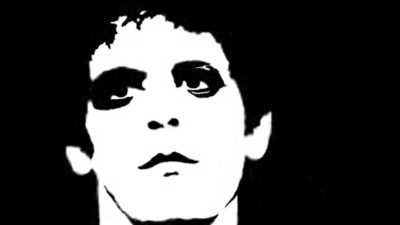Walk on the Wild Side, by Lou Reed, from his second solo album, Transformer, has been on my iTunes playlist forever. The lyrics describe a series of individuals and their journeys to New York – you all know the tune, the backing vocals that go do-do-do, do-do-do-do, do-do. The song was Reed’s biggest single, despite its touching on taboo topics such as transgender, drugs, male prostitution and oral sex.
Produced by David Bowie and Mick Ronson and released as a double A-side with another Reed classic, Perfect Day, Reed’s distinctive deadpan voice, poetic and transgressive lyrics on the track were trademarks throughout his long career. Like many of Reed’s songs, Walk on the Wild Side is based on a simple chord progression – the alternating between C major and F major, or I and IV in harmonic analysis, the pre-chorus introduces the II, D major – creates the hypnotic loop in our head.
The song is also noted for its twin interlocking bass lines played by Herbie Flowers on double bass overdubbed on a stacked knob 1960 fretless Fender Jazz Bass. In an interview, Flowers claimed the reason he came up with the twin bass line was that as a session musician, he would be paid double for playing two instruments on the same track, thus totalling his pay to £34 for his contribution.
It’s a great song for an exercise of mindful listening because it builds gradually with different instrumental elements dropping in and out. Here’s what I’ve taken from listening to Walk on the Wild Side:
0.00 Starts with a single note, followed by a succession of pairs of notes on a bass, with heavy string reverb, then joined by a gentle, strumming acoustic guitar in the background;
0.11 The drums come in, played softly with brushes rather than sticks, creating a laid-back sound;
0.20 Reed’s lead vocal now drops in, deep, resonant but vulnerable, engaging you with the story of the song, not just its sound;
0.33 Hey babe, take a walk on the wild side – the refrain heard for the first time.
0.52 A second bass line, played on an electric base comes in adding a mournful note, drops out at 1.05 before coming back in;
1.11 A single cymbal smash;
1.25 In response to Reed’s powerful lead, those famous female backing vocals make their first appearance, just for 15 seconds or so, building to a crescendo;
1.45 A gentle, sweeping high pitched violin line drifts in taking its cue from the vocal melody and developing into an instrumental flourish between verses; it goes on like this for a bit until…
2.16 The acoustic base jumps to a four-note pattern just for a few bars, and Lou makes a little yelp between verses… HuH
3.10 Lou goes back full on do, do-do, do-do-do-do, do-do, the backing singers pick up the refrain and build to another crescendo; you can still pick out the two bass lines, the brushed drums and the guitar rhythm;
3.37 The vocals drop, and a single soft brushed cymbal heralds a baritone sax solo, that meanders off into the distance, taking you with it, as the song fades;
4.12 The end.
I’ve always had this ritual to go through and analyse my favourite tunes a little more about what it was I was hearing, never been happy just singing along!
Lou Reed stood out from the crowd, shaping the approach of contemporaries as David Bowie, Iggy Pop, and Patti Smith. Reed’s music was listened to by a devoted few. Those few, however, emerged as the shapers of new and powerful strains of popular music – he exercised a pervasive influence on such successors as David Byrne (Talking Heads), Ian Curtis (Joy Division) and Michael Stipe (REM).
His fearlessness to be his own voice was the most distinctive quality he brought to making music, unafraid to jolt his audience by presenting them with new and with striking imagery – Reed notably booted music’s primal look, he wore black, black, and more black, a blatant rejection of the vivid palette of psychedelia and its love-and-peace attitudes of the 1960s.
He met John Cale in 1965, who would become his most important musical collaborator. They settled on calling themselves the Velvet Underground. They were both rudimentary and highly sophisticated. Reed stayed for two albums – check out their second album, White Light/White Heat and the majestic 17-minute Sister Ray. But by 1970 Reed had left the group, disillusioned by its failure to make any sort of commercial impact.
At the end of 1971 he began a series of albums under a new contract with RCA. The first was not a success but the second, Transformer, finally brought him attention, containing Walk on the Wild Side, in which he portrayed a series of picaresque Andy Warhol characters. He was clearly Lou Reed, not to be confused with anyone else. He was who he was, and comfortable with that.
Reed died of liver disease on 27 October 2013, aged 71. I know his songs of the pain and beauty in the world filled many people with the incredible joy he felt for life. Long live the beauty that comes down and through and onto all of us from his music.
What Reed possessed was originality. He was a pioneer, a creator, a restlessly curious, immensely skilled scout for new ideas at the fringes was quite instinctual. Always one step ahead, The Beatles and The Stones shattered the commercial music landscape in the 1960s into a new paradigm and they made music an index of lifestyle. But in just a handful of years, they both reached their commercial peak. Reed embodied something more profound, a self-expression so radical, starting his lifelong journey of ideation, innovation, and regeneration until early C21st.
Even though he arrived in the 1960s, nearly fifty years later he was restless and creative to the last. That desire to always do something new made him not just one of the most gifted musicians of the last fifty years but also one of its most prescient innovators. So how do you do this as a startup founder? Here are some thoughts based on my appreciation of Lou Reed.
Make individual decisions about self-expression and identity In the creation of the Velvet Underground, Reed united the visual and narrative of pop music in a way that had never been seen before. Having gained an audience, it was then a masterstroke to trust that his audience was now primed to accept and delight in successive incarnations and his associated musical genres as a solo artist.
This allowed Reed to always be ‘himself’ while enjoying the licence that came with this appetite to create symbolically unique personas he adopted to carry and complete his latest musical and visual change. The message is clear: innovators, be yourself. If your aim is to be original, you must end up looking and sounding highly unique. He followed Oscar Wilde’s advice: Be yourself; everyone else is already taken.
Staying relevant by creating your own future Musical tastes change, new artists emerge, and the market can move in a new, unexpected direction. For a while in the late 1970s the emergence of punk pushed Reed to an outsider. But he stayed relevant. The unexpected was, after all, Reed’s modus operandi.
But how exactly did his passion for reinvention and transformation manifest itself, and what did it teach us? He showed endless possibilities. He extended out into the new spaces, metaphorically and physically. That man could move. Reed the entrepreneur, the disruptor, the craftsman of his own self, manifesting uniqueness and original thought. The traits of an audacious showman that we can reflect upon as genuine entrepreneurial genes.
Be a thought leader Reed was a thought leaser, an influencer who shaped other people’s thinking. He showed the art of the possible. You can become a thought leader by developing a deep understanding of a specific area, topics or subjects that deeply interest you then be willing to share your knowledge with others, and answer people’s questions on your areas of expertise. Thought leaders are the informed opinion leaders and the go-to people in their field of expertise. They are trusted sources who move and inspire people with innovative ideas.
Create your own market space Brew Dog’s punk positioning strategy is classic originality thinking – if the rest of the market has moved to the right, turn away and head left. With the market dominated by mass-produced similar tasting beers, Brew Dog travelled in the opposite direction and created their own market space. They let everyone else fight for market share in the crowded mass commercial beer market, and created individual craft beers, with a focus on beer drinkers who desired authentic and artisan quality beers at an affordable price.
Reed followed a similar path. Punk makes sense for a startup, challenge the status quo, conventional thinking, and accepted paradigms, be non-conformists, get your point of view across. Reed and Brew Dog communicated their philosophy and attracted like-minded people to a cultural revolution. It was about staying true to their philosophy and creating their own market space to thrive in.
Expect a lot from yourself Don’t let someone else define your agenda, you decide what is possible for you. Dare to believe you can be the best, and make it happen. Embrace challenges and setbacks as defining moments, learn from them, use them as springboards. Don’t care about being right – Steve Jobs used this line in an interview after he was fired by Apple, and I think it’s a great guiding principle for anyone, as a person or business leader.
JRR Tolkien’s words in The Hobbit are inspiring about your choosing your attitude for personal or business growth:
The greatest adventure is what lies ahead
Today and tomorrow are yet to be said
The chances, the changes are all yours to make
The mould of your life is in your hands to break
Regardless of appearances, no one escapes life without enduring tough moments and cul-de-sacs. The truth is life is messy and unpredictable. The difference between those who overcome challenges and those who succumb to them is largely one of attitude – so be true to yourself.
Stay hungry, stay foolish The closing lines from Steve Jobs’ famous 2005 Stanford University speech captures a sentiment that seems on the face of it somewhat flippant, however, when you reflect, it’s a statement about keeping your ambition and being adventurous, never taking yourself too seriously, keeping the zest and attitude of youth.
Check out Job’s inspirational speech here: https://www.youtube.com/watch?v=D1R-jKKp3NA
Reed followed this individualism, with his own idiosyncratic artistic impulses: I have never thought of music as a challenge — you always figure the audience is at least as smart as you are, he wrote. You do this because you like it, you think what you’re making is beautiful. And if you think it’s beautiful, maybe they think it’s beautiful.
Don’t waste your time trying to be a copycat. Be yourself, because those who mind don’t matter, and those who matter don’t mind. Choose to champion novel ideas, battle conformity, and buck prevailing thinking. Don’t be a sheep in wolf’s clothing, or another sheep’s clothing. It’s better to fail in originality than succeed in imitation.
So, take a walk on the wild side, follow the path less taken, and think about why and how you’re different. Be an original in thinking and doing. Trust your intuition and instincts. Believe in yourself. What do you bring to the table that is so memorable, original, and outstanding that people will CHOOSE to do business with you?


